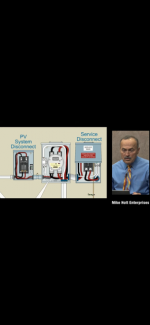Jpflex
Electrician big leagues
- Location
- Victorville
- Occupation
- Electrician commercial and residential
When getting into pv solar systems, apparently the service grounded conductor neutral is jumped from either the grounded conductor buss at the service panel or the neutral lug at the main meter to bond the pv system disconnect?
How do you size this grounded jumper conductor terminating and bonding to the pv system disconnect?
Is this smaller neutral jumper sized to the largest conductors from ac /dc converter terminating to the supply back feed breaker on the load side of service panel buss? Or based the size per the largest ungrounded conductors supplying the service 250.102c?
Where can I find this in code? Thanks
How do you size this grounded jumper conductor terminating and bonding to the pv system disconnect?
Is this smaller neutral jumper sized to the largest conductors from ac /dc converter terminating to the supply back feed breaker on the load side of service panel buss? Or based the size per the largest ungrounded conductors supplying the service 250.102c?
Where can I find this in code? Thanks


